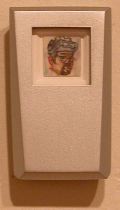 The three artists in Fleisher Challenge 2 are communicators. They speak loudly, and while I found one of them difficult because of her obvious references to death, something I prefer as a subtext and not the perceived thrust of the work, and another difficult because of the found objects used, I commend them all for trying so hard to be clear about what they’re saying.
The three artists in Fleisher Challenge 2 are communicators. They speak loudly, and while I found one of them difficult because of her obvious references to death, something I prefer as a subtext and not the perceived thrust of the work, and another difficult because of the found objects used, I commend them all for trying so hard to be clear about what they’re saying.
Hiro Sakaguchi‘s voice is that of the exile in a foreign land. (top image is “Self Portrait” framed in a kind of cellphone)
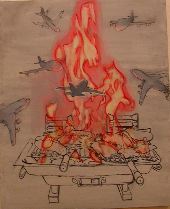
His narrative paintings mix events, words and motifs from the artist’s native Japan with his experience in America. As an Asian in America he understands about communicating and he even produced a little booklet with a “key” to unlocking his works.
He needn’t have. His paintings are readable on many levels and they communicate about his life and about the lives of most of us living in urban megalopolises in 2004. Sakaguchi’s got a poetic, eliptical way of expressing himself and his works are a mix of sushi and hamburgers. In one work, for example he riffs on the different meanings of hibachi, a Japanese word adopted all the way up and down the food chain in America. In Japan the word means a hand warmer. Here of course it’s the tabletop grill. But in his painting the artist takes it to another, weirder level by inserting the thought of moths drawn to the flame — or airplanes flying above the flames. (image is “Hibachi Night”). I’m not sure what the image “says” exactly but what it communicates is a kind of cross-cultural, global wounding that involves people, war, and a fire that’s out of control.
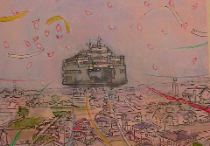
The artist’s one sentence statement — printed in about 36 pt. type in my press packet is so great I have to quote it here. It’s a quiet manifesto that could be (should be?) relevant for all artists working today:
“I am interested in making an object which contains a fictional realm that is relevant to my life experience as an artist and an individual in this global society.” (image is “Wind, Flower and Farewell”)
Sakaguchi is a natural born globalist and his Tokyo by South Philadelphia mix is one to watch.
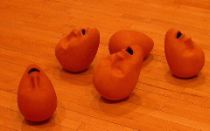
Rachel Clark‘s sculptural installation “Returning” consists of an array of stylized clay heads on the floor, each piece an individual with open mouth and eyes closed. The rounded vessels are filled with water. There are also some clay feet growing down from the ceiling and I almost missed them so focussed was I on not walking in to some of the breakable and spillable heads. The overall effect of this installation is a ghostly pumpkin patch (I’m sorry, it’s Halloween season my photographs of this piece all have an orange cast). I understand the art references to Brancusi and the metaphorical references to people as vessels but I can’t get past the objects’ open mouths and their reading of life’s last gasp.
Had the mouths been closed or perhaps had the load been lightened a bit by the insertion of a little bird here or there or some other symbol of life I would have found the piece more reflective of the complete package of life and death. Perhaps there’s another reading someone with a more Zen outlook can suggest?
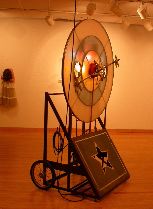
Stephen Binasiewicz is a found object sculptor and his work here is a melange of motorized and non-motorized pieces that have a century’s-past carnivalesque character. Squeaking mechanical arms lift red, yellow and blue lights in one work whose front side is a kind of spinning target (image is “Shoot”). There is a bit of the obsessive outsider/tinkerer in Binasiewicz’s work and I kind of liked the rhythmic sounds of the mechanical arms trying so hard to lift their burdens again and again.
The artist says he’s working autobiographically and that he loves found objects. I felt the love but didn’t get the memoir of his life. What I did pick up is the sad affect that comes from using old things (dolls, clothes, etc) and not transforming them enough. Apart from the two large pieces that moved (“Shoot” and “Hive”), the rest of the works were kind of creepy in a sideshow way. Perhaps the artist could push the narrative a bit and then the viewer would find a way in and past the found objects to the meat of the message.
Binasiewicz is the founder of the Philadelphia sculpture and set design fabrication lab, Kitchen Sink. The lab has worked on sculpture for Stephen Robin, Yinka Shoniabare and Jeanne Jaffe.









